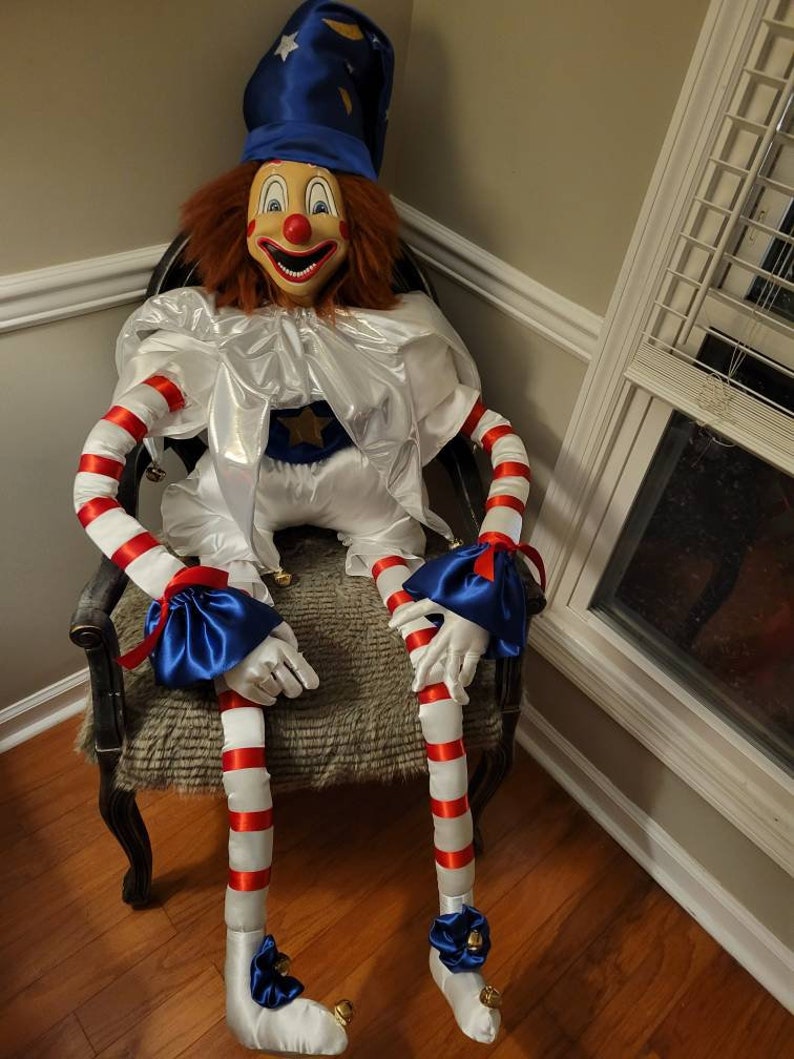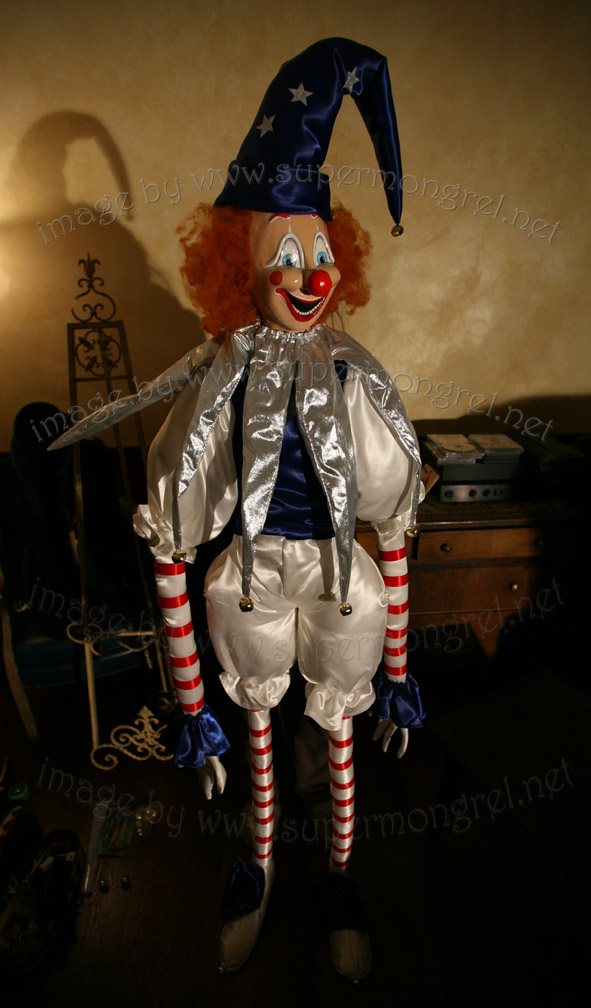Poltergeist Clown: The Terrifying Phenomenon That Keeps Us Up At Night
Poltergeist clown is a term that has become synonymous with fear and unease in the paranormal world. It refers to the unsettling sightings and encounters involving clowns that defy natural explanations. These ghostly clowns have been reported across the globe, leaving behind a trail of chilling experiences and unanswered questions. Whether you believe in the supernatural or not, the stories surrounding poltergeist clowns are enough to send shivers down anyone's spine.
The fascination with clowns as figures of fear has grown exponentially over the years, thanks in part to pop culture's portrayal of them as malevolent entities. Movies like "It" and various urban legends have further cemented the idea of clowns as harbingers of dread. However, the phenomenon of poltergeist clowns goes beyond mere fiction, delving into the realm of real-life encounters that continue to baffle investigators and enthusiasts alike.
In this comprehensive guide, we will explore the origins, history, and significance of poltergeist clowns. By examining real-life accounts, psychological perspectives, and cultural influences, we aim to shed light on this mysterious phenomenon. Whether you're a skeptic or a believer, this article will provide valuable insights into why clowns have become such an enduring symbol of fear in our collective consciousness.
Read also:Alisyn Camerota Daughters A Closer Look At Her Family Life And Influence
Table of Contents
- The Origin of Poltergeist Clown
- History of Clown Fear
- Understanding the Poltergeist Clown Phenomenon
- Psychology Behind Clown Fear
- Clowns in Popular Culture
- Real-Life Poltergeist Clown Encounters
- Investigating Poltergeist Clowns
- Statistics and Studies
- Skeptical Perspectives
- Conclusion and Final Thoughts
The Origin of Poltergeist Clown
The concept of poltergeist clown can be traced back to ancient folklore and mythology. Clowns, originally intended as comedic figures, have evolved over time to become symbols of dread and uncertainty. The term "poltergeist" itself originates from German, meaning "noisy ghost," and when combined with the image of a clown, it creates a terrifying hybrid of supernatural and human-like fear.
Clowns in Early Mythology
Historically, clowns were often depicted as mischievous spirits or tricksters in various cultures. For instance, Native American tribes had their own versions of clown-like figures, known as "contraries," who acted opposite to societal norms. These characters were both revered and feared for their ability to disrupt the natural order.
As societies evolved, so did the portrayal of clowns. In medieval Europe, jesters and court fools were common figures, but they were also associated with unpredictability and chaos. This duality of humor and danger laid the groundwork for the modern perception of clowns as potentially malevolent beings.
History of Clown Fear
The fear of clowns, or coulrophobia, has deep roots in human psychology. While clowns were traditionally seen as entertainers, their exaggerated features and unpredictable behavior have always evoked a sense of unease in some individuals. This unease intensified with the rise of horror films and media that capitalized on the fear of clowns.
Clowns in the 20th Century
The 20th century marked a turning point in the perception of clowns. The infamous serial killer John Wayne Gacy, who dressed as a clown during his performances, further solidified the image of clowns as sinister figures. His crimes brought widespread attention to the darker side of clown culture, influencing countless works of fiction and non-fiction alike.
Understanding the Poltergeist Clown Phenomenon
Poltergeist clowns represent a unique intersection of supernatural beliefs and cultural anxieties. These ghostly clowns are often described as floating, shape-shifting entities that appear in dreams or during moments of heightened fear. Their presence is said to be accompanied by strange noises, unexplained movements, and an overwhelming sense of dread.
Read also:Rihannas Last Name Unveiling The Story Behind The Iconic Singers Surname
Characteristics of Poltergeist Clowns
- Unsettling laughter that echoes through empty spaces
- Ability to appear and disappear at will
- Distorted facial features that change over time
- Connection to haunted locations or personal trauma
These characteristics have been documented in various accounts, adding to the mystery and allure of poltergeist clowns.
Psychology Behind Clown Fear
From a psychological perspective, the fear of clowns can be attributed to several factors. The exaggerated features of clowns, such as their painted faces and oversized clothing, create a sense of "uncanny valley," where familiarity meets unfamiliarity. This cognitive dissonance triggers fear in some individuals.
Additionally, clowns often embody the unknown, representing the unpredictable nature of life itself. In a world where control is highly valued, the presence of clowns challenges our need for order and predictability, leading to discomfort and fear.
Clowns in Popular Culture
Pop culture has played a significant role in shaping the modern perception of clowns. Movies, books, and television shows have consistently portrayed clowns as malevolent beings, reinforcing the idea of clowns as symbols of fear. Some notable examples include:
- "It" by Stephen King, which features the terrifying Pennywise the Dancing Clown
- "Killer Klowns from Outer Space," a cult classic that combines science fiction with clown horror
- "Poltergeist" (1982), which features a clown doll as a harbinger of supernatural events
These works of fiction have contributed to the widespread fear of clowns, influencing both children and adults alike.
Real-Life Poltergeist Clown Encounters
While many stories of poltergeist clowns are rooted in fiction, there are numerous accounts of real-life encounters that defy explanation. These stories come from individuals who claim to have experienced supernatural encounters with ghostly clowns, leaving lasting impressions on their lives.
Case Studies
One such case involves a family in rural Ohio who reported seeing a floating clown outside their home late at night. The clown allegedly followed them wherever they went, causing sleepless nights and a pervasive sense of dread. Despite thorough investigations, no logical explanation could be found for their experiences.
Another account comes from a young woman in Florida who claimed to have been visited by a clown in her dreams. The clown would whisper her name and touch her, leaving behind physical marks on her skin. This case gained attention from paranormal investigators, who were unable to provide a definitive explanation for the phenomenon.
Investigating Poltergeist Clowns
Paranormal investigators and researchers have dedicated significant time and resources to studying the phenomenon of poltergeist clowns. Through interviews, surveys, and field investigations, they aim to uncover the truth behind these unsettling encounters.
Methods of Investigation
- Conducting interviews with individuals who claim to have encountered poltergeist clowns
- Using electronic voice phenomena (EVP) devices to capture potential ghostly communications
- Examining historical records and folklore for clues about the origins of poltergeist clowns
While progress has been made, the mystery of poltergeist clowns remains largely unsolved, leaving researchers with more questions than answers.
Statistics and Studies
Several studies have been conducted to better understand the prevalence of clown fear and its impact on individuals. According to a study published in the Journal of Anxiety Disorders, approximately 7.8% of the population experiences some level of fear related to clowns. This percentage is higher among children and adolescents, suggesting that clown fear may be more pronounced during formative years.
Another study conducted by the American Psychological Association found that individuals with a history of trauma or anxiety disorders are more likely to experience intense fear when exposed to clown imagery. These findings highlight the complex interplay between personal experiences and cultural influences in shaping our perceptions of clowns.
Skeptical Perspectives
Not everyone believes in the existence of poltergeist clowns. Skeptics argue that these encounters can often be attributed to psychological phenomena such as sleep paralysis or hyperactive imagination. They point out that the human brain is wired to seek patterns and meaning, even in random occurrences, which may explain why some people perceive clowns as supernatural entities.
Despite these arguments, believers maintain that the sheer number of consistent accounts across different cultures and time periods suggests there may be more to the phenomenon than meets the eye.
Conclusion and Final Thoughts
The phenomenon of poltergeist clowns continues to captivate and terrify people around the world. From ancient folklore to modern-day accounts, the image of the ghostly clown has evolved into a powerful symbol of fear and uncertainty. While scientific explanations may exist for some encounters, the mystery of poltergeist clowns remains largely unsolved, leaving room for both belief and skepticism.
We invite you to share your thoughts and experiences in the comments section below. Whether you're a believer or a skeptic, your input is valuable in helping us understand this fascinating phenomenon. Don't forget to explore our other articles for more insights into the paranormal world!


